2011 HONDA ODYSSEY engine overheat
[x] Cancel search: engine overheatPage 4 of 722
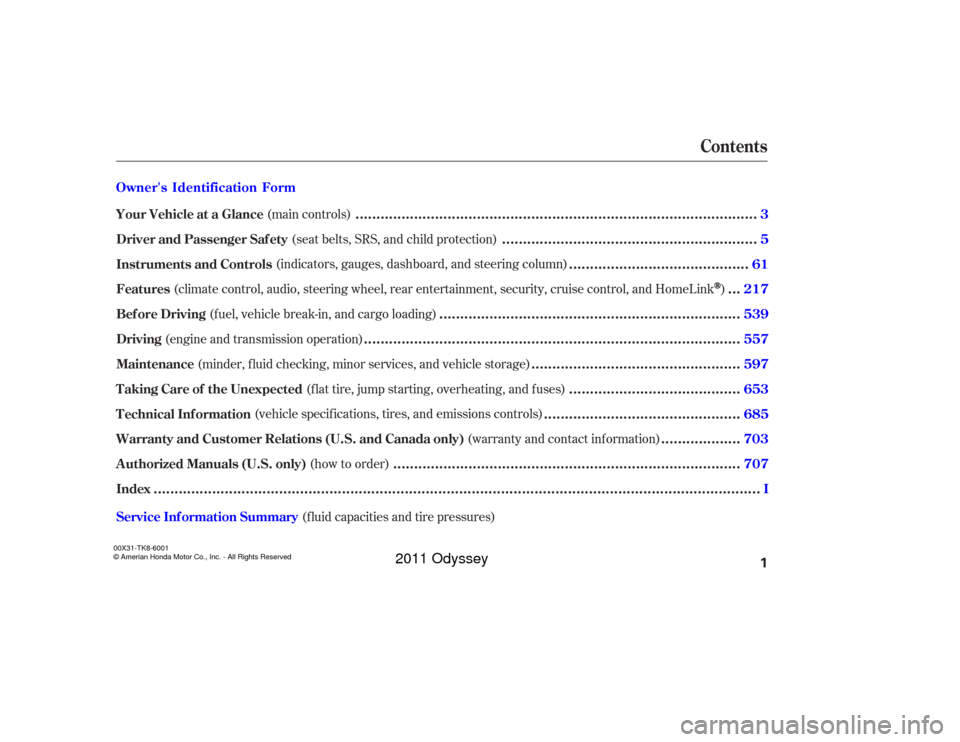
(f luid capacities and tire pressures)
(main controls)
(seat belts, SRS, and child protection)
(indicators, gauges, dashboard, and steering column)
(climate control, audio, steering wheel, rear entertainment, security, cruise control, and HomeLink
)
(fuel, vehicle break-in, and cargo loading)
(engine and transmission operation) (minder, f luid checking, minor services, and vehicle storage) (f lat tire, jump starting, overheating, and f uses)
(vehicle specif ications, tires, and emissions controls) (warranty and contact inf ormation)
(how to order)
Contents
........................................................................\
........................................................................
Index .I
Service Inf ormation Summary ........................................................................\
.......................
Your Vehicle at a Glance .3
............................................................
Driver and Passenger Saf ety .5
..........................................
Instruments and Controls .61
..
Features .217
.......................................................................
Bef ore Driving .539
........................................................................\
.................
Driving .557
.................................................
Maintenance .597
........................................
T aking Care of the Unexpected .653
..............................................
T echnical Inf ormation .685
..................
Warranty and Customer Relations (U.S. and Canada only) .703
........................................................................\
..........
A uthorized Manuals (U.S. only) .707
1
10/07/17 09:34:16 31TK8600_006
Owner's Identification Form
2011 Odyssey 00X31-TK8-6001
Page 575 of 722

When the low tire pressure indicator
is on, one or more of your tires is
signif icantly underinf lated. You
should stop and check your tires as
soon as possible, and inf late them to
the proper pressure as indicated on
the vehicle’s tire inf ormation placard.
If you think you can saf ely drive a
short distance to a service station,
proceed slowly, and inf late the tire to
the recommended pressure shown
on the driver’s doorjamb.
If the tire is f lat, or if the tire
pressure is too low to continue
driving, replace the tire with the
compact spare tire (see page ).
If you cannot make the low tire
pressure indicator go out af ter
inflating the tires to the specified
values, have your dealer check the
system as soon as possible.Driving on a signif icantly under
inf lated tire causes the tire to
overheat and can lead to tire failure.
Underinf lation also reduces f uel
efficiency and tire tread life, and may
af f ect the vehicle’s handling and
stopping ability.
Becausetirepressurevariesby
temperature and other conditions,
the low tire pressure indicator may
come on unexpectedly.
Each tire has its own pressure
sensor (not including the spare tire).
If the air pressure of a tire becomes
signif icantly low while driving, the
sensor in that tire immediately sends
a signal that causes the low tire
pressure indicator to come on. Your vehicle is equipped with a tire
pressure monitoring system (TPMS)
that turns on every time you start the
engine and monitors the pressure in
your tires while driving.
655
Except Touring models
Low Tire Pressure
Indicator
Tire Pressure Monitoring System (TPMS)572
10/07/17 10:51:23 31TK8600_577
2011 Odyssey
Page 598 of 722
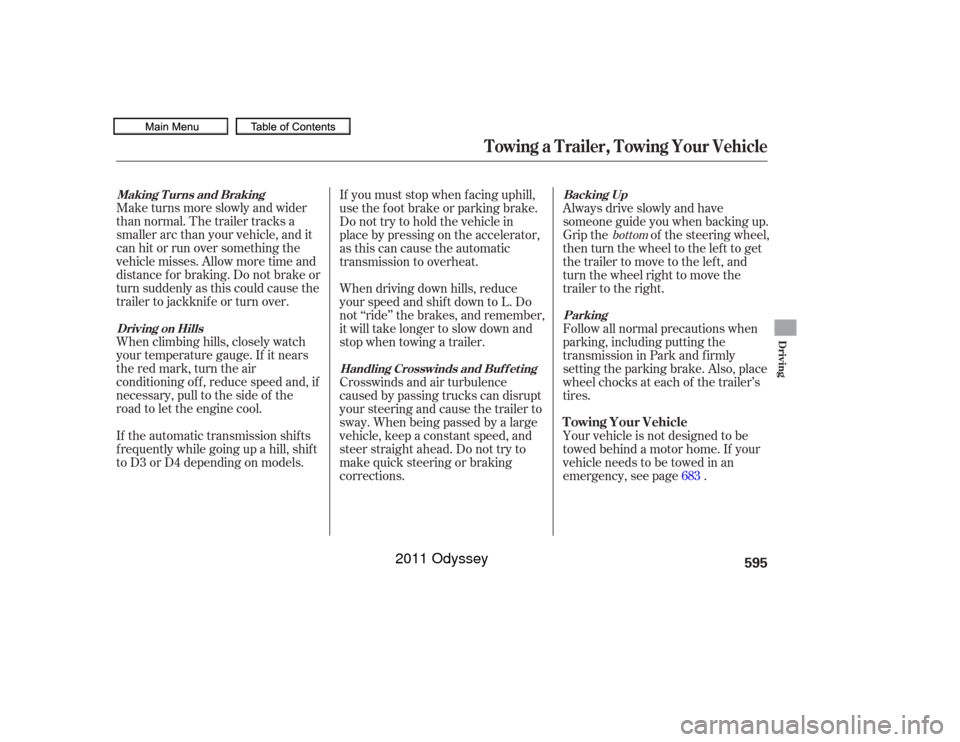
Maketurnsmoreslowlyandwider
than normal. The trailer tracks a
smaller arc than your vehicle, and it
canhitorrunoversomethingthe
vehicle misses. Allow more time and
distance f or braking. Do not brake or
turn suddenly as this could cause the
trailer to jackknif e or turn over.
When climbing hills, closely watch
your temperature gauge. If it nears
the red mark, turn the air
conditioning of f , reduce speed and, if
necessary, pull to the side of the
road to let the engine cool.Always drive slowly and have
someone guide you when backing up.
Grip the of the steering wheel,
then turn the wheel to the left to get
the trailer to move to the lef t, and
turn the wheel right to move the
trailer to the right.
Follow all normal precautions when
parking, including putting the
transmission in Park and f irmly
setting the parking brake. Also, place
wheel chocks at each of the trailer’s
tires.
If you must stop when f acing uphill,
use the f oot brake or parking brake.
Do not try to hold the vehicle in
placebypressingontheaccelerator,
as this can cause the automatic
transmission to overheat.
Your vehicle is not designed to be
towed behind a motor home. If your
vehicle needs to be towed in an
emergency, see page .
If the automatic transmission shif ts
f requently while going up a hill, shif t
to D3 or D4 depending on models. When driving down hills, reduce
your speed and shif t down to L. Do
not ‘‘ride’’ the brakes, and remember,
it will take longer to slow down and
stop when towing a trailer.
Crosswinds and air turbulence
caused by passing trucks can disrupt
your steering and cause the trailer to
sway. When being passed by a large
vehicle, keep a constant speed, and
steer straight ahead. Do not try to
make quick steering or braking
corrections.
683
bottom
Making T urns and Braking
Driving on Hills Backing Up
Parking
Handling Crosswinds and Buf f et ing
Towing Your Vehicle
Towing a Trailer, Towing Your Vehicle
Driving
595
10/07/17 10:54:10 31TK8600_600
2011 Odyssey
Page 632 of 722
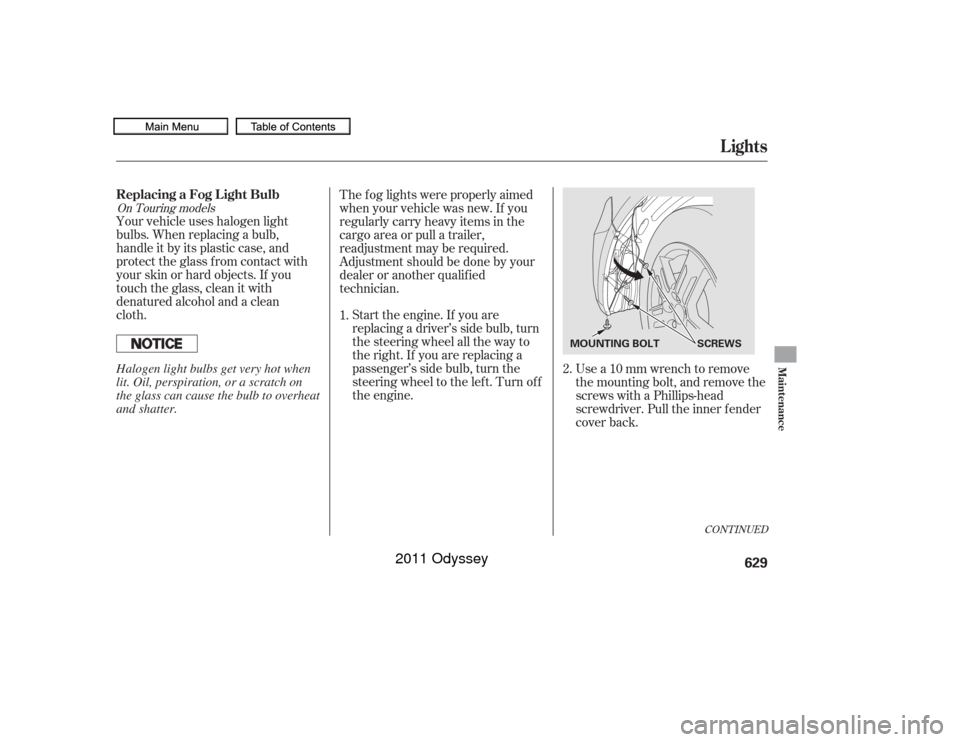
CONT INUED
Your vehicle uses halogen light
bulbs. When replacing a bulb,
handle it by its plastic case, and
protect the glass f rom contact with
your skin or hard objects. If you
touch the glass, clean it with
denatured alcohol and a clean
cloth.Thefoglightswereproperlyaimed
when your vehicle was new. If you
regularly carry heavy items in the
cargo area or pull a trailer,
readjustment may be required.
Adjustment should be done by your
dealer or another qualif ied
technician.
Start the engine. If you are
replacing a driver’s side bulb, turn
the steering wheel all the way to
theright.If youarereplacinga
passenger’s side bulb, turn the
steering wheel to the lef t. Turn of f
the engine. Use a 10 mm wrench to remove
the mounting bolt, and remove the
screws with a Phillips-head
screwdriver. Pull the inner f ender
cover back.
1.
2.On Touring models
Lights
ReplacingaFogLightBulb
Maint enance
629
SCREWS
MOUNTING BOLT
Halogen light bulbs get very hot when
lit. Oil, perspiration, or a scratch on
the glass can cause the bulb to overheat
and shatter.
10/07/17 10:58:25 31TK8600_634
2011 Odyssey
Page 656 of 722
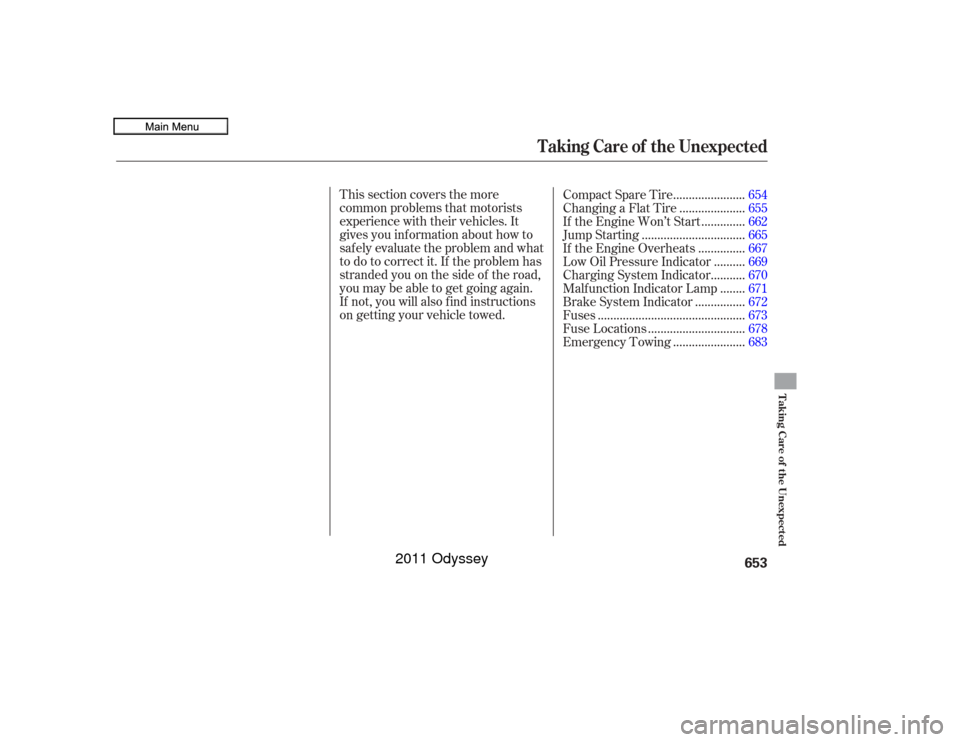
This section covers the more
common problems that motorists
experience with their vehicles. It
gives you inf ormation about how to
safely evaluate the problem and what
to do to correct it. If the problem has
stranded you on the side of the road,
you may be able to get going again.
If not, you will also f ind instructions
on getting your vehicle towed.......................
Compact Spare Tire .654
....................
Changing a Flat Tire .655
.............
If the Engine Won’t Start . 662
................................
Jump Starting .665
..............
If the Engine Overheats . 667
.........
Low Oil Pressure Indicator . 669
..........
Charging System Indicator . 670
.......
Malf unction Indicator Lamp . 671
...............
Brake System Indicator . 672
..............................................
Fuses .673
..............................
Fuse Locations .678
......................
Emergency Towing .683
Taking Care of the Unexpected
Taking Care of the Unexpected
653
10/07/17 11:01:44 31TK8600_658
2011 Odyssey
Page 670 of 722
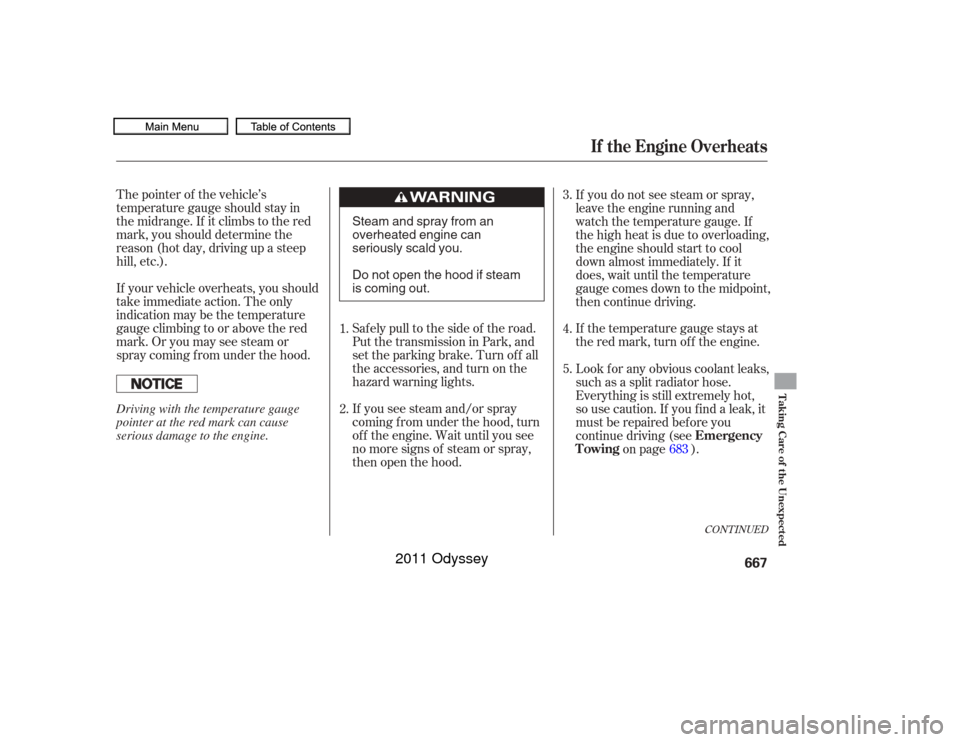
The pointer of the vehicle’s
temperature gauge should stay in
the midrange. If it climbs to the red
mark, you should determine the
reason (hot day, driving up a steep
hill, etc.).
If your vehicle overheats, you should
take immediate action. The only
indication may be the temperature
gauge climbing to or above the red
mark. Or you may see steam or
spray coming f rom under the hood.If you see steam and/or spray
coming f rom under the hood, turn
of f the engine. Wait until you see
no more signs of steam or spray,
then open the hood.If the temperature gauge stays at
the red mark, turn off the engine.
Saf ely pull to the side of the road.
Put the transmission in Park, and
set the parking brake. Turn of f all
the accessories, and turn on the
hazard warning lights. If you do not see steam or spray,
leave the engine running and
watch the temperature gauge. If
the high heat is due to overloading,
the engine should start to cool
down almost immediately. If it
does, wait until the temperature
gauge comes down to the midpoint,
then continue driving.
Look f or any obvious coolant leaks,
such as a split radiator hose.
Everything is still extremely hot,
so use caution. If you f ind a leak, it
must be repaired bef ore you
continue driving (see
on page ).
1.
2. 3.
4.
5.
683
CONT INUED
If theEngineOverheats
Emergency
Towing
Taking Care of the Unexpected
667
Steam and spray from an
overheated engine can
seriously scald you.
Do not open the hood if steam
is coming out.
Driving with the temperature gauge
pointer at the red mark can cause
serious damage to the engine.
10/07/17 11:03:30 31TK8600_672
2011 Odyssey
Page 671 of 722
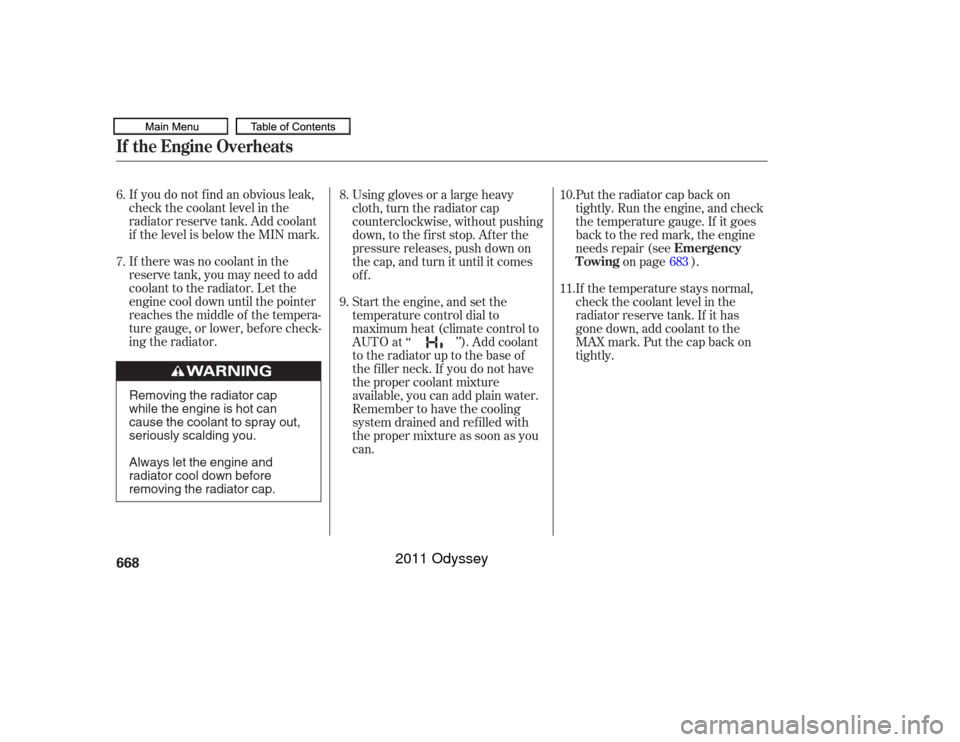
If you do not f ind an obvious leak,
check the coolant level in the
radiator reserve tank. Add coolant
if the level is below the MIN mark.
If there was no coolant in the
reserve tank, you may need to add
coolant to the radiator. Let the
engine cool down until the pointer
reaches the middle of the tempera-
ture gauge, or lower, bef ore check-
ing the radiator.Using gloves or a large heavy
cloth, turn the radiator cap
counterclockwise, without pushing
down, to the f irst stop. Af ter the
pressure releases, push down on
the cap, and turn it until it comes
off.
Start the engine, and set the
temperature control dial to
maximum heat (climate control to
AUTO at ‘‘ ’’). Add coolant
to the radiator up to the base of
the f iller neck. If you do not have
the proper coolant mixture
available, you can add plain water.
Remember to have the cooling
system drained and ref illed with
the proper mixture as soon as you
can.Put the radiator cap back on
tightly. Run the engine, and check
the temperature gauge. If it goes
back to the red mark, the engine
needs repair (see
on page ).
If the temperature stays normal,
check the coolant level in the
radiator reserve tank. If it has
gone down, add coolant to the
MAX mark. Put the cap back on
tightly.
6.
7.
8.
9.10.
11.
683
If theEngineOverheats
Emergency
Towing
668
Removing the radiator cap
while the engine is hot can
cause the coolant to spray out,
seriously scalding you.
Always let the engine and
radiator cool down before
removing the radiator cap.
10/07/17 11:03:37 31TK8600_673
2011 Odyssey
Page 713 of 722
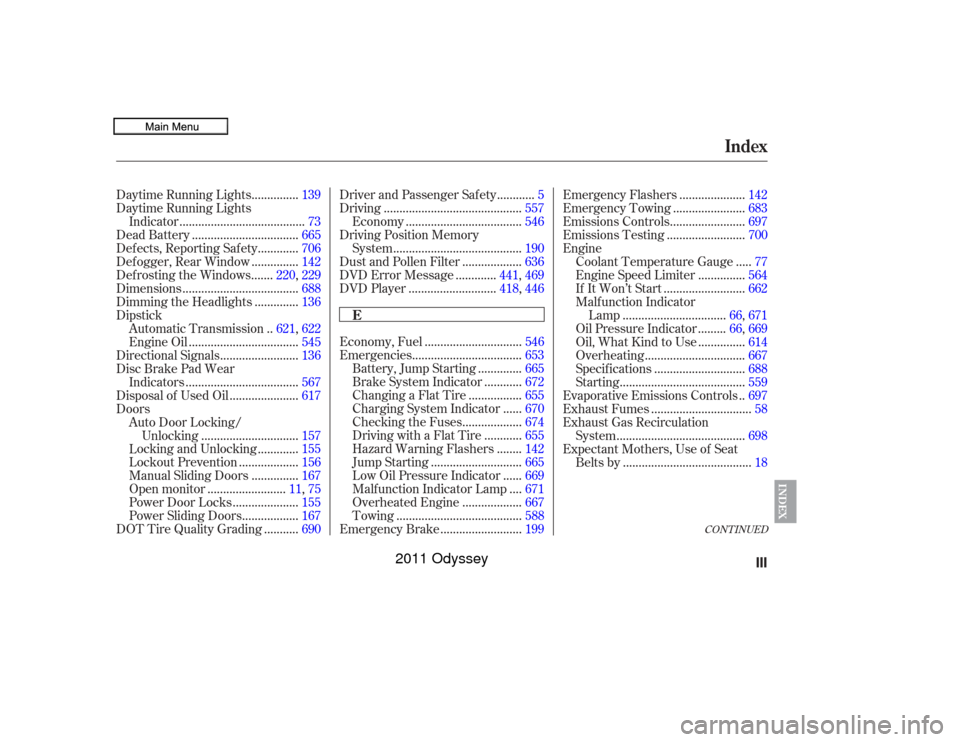
CONT INUED
..............................
Economy, Fuel .546
..................................
Emergencies .653
.............
Battery, Jump Starting . 665
...........
Brake System Indicator . 672
................
Changing a Flat Tire . 655
.....
Charging System Indicator . 670
..................
Checking the Fuses . 674
...........
Driving with a Flat Tire . 655
.......
Hazard Warning Flashers . 142
............................
Jump Starting .665
.....
Low Oil Pressure Indicator . 669
...
Malf unction Indicator Lamp . 671
..................
Overheated Engine . 667
.......................................
Towing .588
.........................
Emergency Brake .199 ....................
Emergency Flashers .142
......................
Emergency Towing .683
.......................
Emissions Controls .697
........................
Emissions Testing .700
Engine ....
Coolant Temperature Gauge . 77
..............
Engine Speed Limiter . 564
.........................
If It Won’t Start .662
Malf unction Indicator ................................
Lamp .66, 671
........
Oil Pressure Indicator . 66,669
..............
Oil, What Kind to Use . 614
...............................
Overheating .667
............................
Specif ications .688
.......................................
Starting .559
.
Evaporative Emissions Controls . 697
...............................
Exhaust Fumes .58
Exhaust Gas Recirculation ........................................
System .698
Expectant Mothers, Use of Seat ........................................
Belts by .18
..............
Daytime Running Lights . 139
Daytime Running Lights .......................................
Indicator .73
.................................
Dead Battery .665
............
Def ects, Reporting Saf ety . 706
..............
Def ogger, Rear Window . 142
......
Def rosting the Windows . 220,229
....................................
Dimensions .688
.............
Dimming the Headlights . 136
Dipstick .
Automatic Transmission . 621,622
..................................
Engine Oil .545
........................
Directional Signals .136
Disc Brake Pad Wear ...................................
Indicators .567
.....................
Disposal of Used Oil .617
Doors Auto Door Locking/ ..............................
Unlocking .157
............
L ocking and Unlocking .
155
..................
Lockout Prevention . 156
..............
Manual Sliding Doors . 167
........................
Open monitor .11, 75
....................
Power Door Locks . 155
.................
Power Sliding Doors . 167
..........
DOT Tire Quality Grading . 690 ...........
Driver and Passenger Safety . 5
...........................................
Driving .557
....................................
Economy .546
Driving Position Memory ........................................
System .190
..................
Dust and Pollen Filter . 636
............
DVD Error Message . 441,469
...........................
DVD Player .418, 446
Index
E
INDEX
III
10/07/17 11:08:41 31TK8600_716
2011 Odyssey